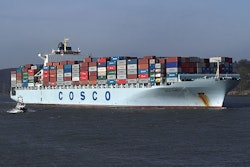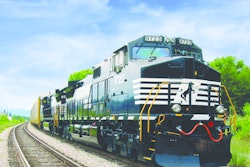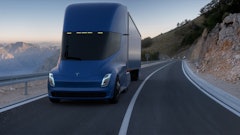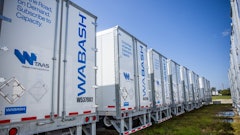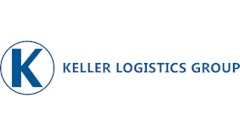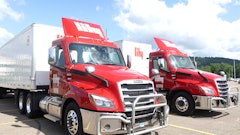Depressed fuel prices have been one of the bright spots for fleet operations in 2015. But most industry observers don’t expect diesel prices to remain where they are indefinitely. Which is why the North American Council for Freight Efficiency (NACFE) has been hard at work studying alternative fuels and strategies for economic alternatives.
Earlier this year, NACFE released its 2015 annual fleet fuel study, which reported on the status of various practices and technologies for improving freight efficiency among 14 major North American fleets. The report reported the progress of fuel efficiency technologies’ adoption and highlighted benchmark competencies in several different areas.
The participating fleets include several logistics and food companies: FritoLay, C.R. England Global Transportation, UPS, Challenger Motor Freight, Con-way Truckload, Crete Carrier, Real Fleets, Nussbaum, Paper Transport Inc., Prime Inc., Ryder, Schneider National, Bison Transport and Werner Enterprises.
The NACFE study’s goal was to quantify adoption levels for 68 transportation technologies and practices and the results they drove for the participating organizations. All 68 technologies are commercially available and are not prototypes.
The study gathered data on the habits of the 14 fleets representing more than 53,000 tractors and close to 160,000 trailers. Fleets provided data on the vehicles, specifying technologies and purchased the fuel for the tractors.
The survey encompasses Class 8 day cab and sleeper tractors and trailers in long haul and regional applications.
The report presents adoption rates by fleet for each technology, in addition to highlights on transmissions, aerodynamics availability for CNG tractors, and engine parameters. In addition, it provides information on recent tractors and trailers placed into service in 2014.
The fleets adopted 30 percent to 54 percent of the available technologies.
From 2011 to 2014, average fuel efficiency improved on account of an increase in the adoption of new fuel efficiency technologies.
Fleets adopting new technology
The study found the adoption of fuel-saving technologies increased from 18 percent in 2003 to 42 percent in 2014. The fleets achieved an average 7.0 mpg for all trucks, while 2015 model year trucks reached as high as 8.5 mpg, compared to the 5.9 mpg national average reported by the U.S. Department of Transportation Federal Highway Administration.
The fleets adopted a combination of the nearly 70 available technologies and engaged the resources of Trucking Efficiency, a joint effort of NCFE and Carbon War Room, a non-profit that seeks to reduce carbon emissions globally.
“The dramatic improvement in fuel economy of the leading fleets this year is exciting,” says Mike Roeth, operation lead for Trucking Efficiency and executive director of NACFE. “If we can get the owners and operators of the 1.5 million tractor-trailers on the road today to invest in more of these technologies, we will see significant reduction in fuel consumptions.”
For every 1 percent reduction in fuel use industrywide, 260 million gallons of fuel ($1 billion per year) is saved.
The main finding is that the 14 fleets are expanding their adoption of the new technologies and they are experiencing improved fuel economy. The fleets reported average fuel savings in 2014 between 6.1mpg and the 7.0 mpg, which translates into a $9,000 annually per truck. This marks an improvement over the 2011 report where the original eight fleets reported annual savings of $4,000 per truck.
Three additional highlights emerged:
• The growth in electronically-controlled transmissions and automated manual transmissions (AMTs).
• Frito Lay’s adoption of aerodynamic day cabs – for diesel tractors and for natural gas tractors.
• Small fleet utilizing engine parameters. The report noted Cummins’ sharing large uptake in PowerSpec downloads, indicating the level of end users taking advantage of electronic engine parameters.
• The purchased adoption rate for new technologies rose from 18 percent to 42 percent from 2003 to 2014. The average fuel economy performance improved 0.8 mpg, as shown in Figure 1. The chart includes a “business as usual” line to compare what the average mpg might have been with the combined impact of 2002, 2007 and 2010 emission regulations, the addition of selective catalytic reduction, and the impact of 2014 GHG base powertrain improvements.
The study was conducted in an environment with fuel costs averaging $4.00 per gallon in the four years up until the end of 2014 for the tractor-trailer industry. The costs have caused fleets to seek fuel efficiency in new equipment specifications and operating strategies.
NACFE grouped technologies into seven segments: tractor aerodynamics, trailer aerodynamics, powertrains, tires/wheels, idle reduction, chassis, and fleet practices. All categories posted increasing levels of adoption. Trailer aerodynamics increased the most in the last five years. (See Fig. 7).
Adopting technology faces challenges
The diversity of industry needs can make adoption of fuel technology difficult. Needs are driven by multiple and sometimes incompatible demands, such as access to capital, risk tolerance level, and business model (i.e., lease versus purchase, in-house operation or leased fleets, in-house or contracted maintenance.) Fleets also operate in different duty cycles due to the type of operating location (rural versus urban) and geographic factors. Such difference can make it challenging to decide which technologies to pursue.
NACFE developed a methodology for sharing best practices to allow companies to learn from data-driven fleets. The organization wanted to provide a roadmap for new technologies.
The survey gathered information on the percent of the fleet’s annual purchases that include any of the 68 technologies for lowering fuel consumption, from 2003 to 2014. Fleets also shared fleet-wide fuel efficiency information in terms of miles driven and fuel consumed.
The survey provides nearly 11,500 data points of buying behavior on new features.
The report developed adoption curves for all 68 technologies, diversity of adoption, and the fuel economy average for all 12 years studied.
The report acknowledges that diesel fuel prices declined to their lowest level in five years, but it notes the prices will not stay low indefinitely. The U.S. Energy Information Administration predicts on-highway retail diesel will return to $3.25 per gallon by 2016. And that prices will rise to more than $6 per gallon by 2040.
The report further notes there are other reasons than fuel price to improve fuel economy. Better fuel economy reduces bottom line expenses.
The report does not weight the data by the number of tractors or trailers the fleet bought per year. It measures fleet decisions as opposed to the number of vehicles with the technologies. A small fleet’s decision buying 100 trucks per year carries the same value as a larger fleet buying thousands.
The report also has a spreadsheet giving miles travelled by each fleet as an adoption percentage. This provides a representation of the mount of new technology purchased each year. The methodology values the purchase of 2,000 vehicles of a given technology as 20 times more than a fleet buying only 100 trucks.
NACFE evaluated consistency of adoption by fleets. It compares each of the 68 technology decisions (to adopt or not) by each of the fleets using a methodology indicating if the technology is purchased by the fleet, how fast the fleet moved from testing to specifying it on all purchases, or if it decided to stop buying after an initial deployment.
Frito Lay explores aerodynamics and CNG
Frito Lay has been pursuing fuel savings and freight efficiency on their tractors and trailers for about 10 years. Aerodynamic devices were not historically generally offered on day cab tractors, like the ones operated by Frito Lay, as it was assumed their benefit was not sufficient as trucks’ operated at lower average speeds unlike to sleeper tractors in long-haul applications.
In 2004 to 2006, Frito Lay spearheaded an effort with a number of tractor manufacturers to add more aerodynamic devices to its day cabs, and by 2007 the company introduced cab extenders, with chassis skirts following in 2009. (Figure 15) These were two of many features adopted by Frito Lay that increased their fleet-wide average fuel economy over the last few years.
In 2011, Frito Lay decided to pursue CNG-powered trucks, beginning procurement in 2012 and ramping to about 80 percent of purchases by 2013. The company found these trucks were not available with cab extenders and chassis skirts, as fuel tank package designs were emerging to satisfy the fuel capacity for the required range of these trucks, which interfered with available designs of the aerodynamics.
Meanwhile, in spite of Frito Lay’s requests, tractor OEMs remained focused on improving the aerodynamics of sleeper tractors, and struggled to justify the product development of these aerodynamic devices on the smaller purchase volume of CNG day cabs.
By collaborating with tractor builders and aerodynamics and fuel tank manufacturers, Frito-Lay’s 2015 purchase of CNG tractors will have the aerodynamics desired included. This is important as the fleet-wide fuel efficiency of the Frito Lay fleet has dropped a bit in the last few years due to this issue.
By 2008, 90 percent of the trucks in this study had optimized electronic engine parameters for fuel economy, and 100 percent did by 2014. Choosing the appropriate settings for the initial electronic engine parameters of a truck, then going through the process to optimize them, delivers fuel savings of as much as 8 percent.
Large fleets lead in exploiting engine parameters
That report also found that large fleets are exploiting engine parameters but that smaller fleets lack the resources to manage the selecting and upkeep of the parameters on their trucks. Hence, the small fleets do nothing to customize these parameters for their operations.
The survey indicates a growing use of fuel savings systems and procedures. Since not all fleets operate under the same philosophies and operation conditions, strategies and results differ among fleets. NACFE, in conjunction with Trucking Efficiency, presents workshops to allow fleets, dealerships and industry suppliers to gather in an environment of open discussions regarding these technology changes.
For more information:
Carbon War Room, carbonwarroom.com
North American Council For Freight Efficiency, nacf.org
Trucking Efficiency, truckinefficiency.org
U.S. Energy Information Administration, eia.gov






